MattWade/New York | |
|---|---|
| Country | United States |
| Before statehood | Province of New York |
| Admitted to the Union | July 26, 1788 (11th) |
| Capital | Albany |
| Largest city | New York City |
| Largest metro and urban areas | New York metropolitan area |
| Government | |
| • Governor | Andrew Cuomo ( D) |
| • Lieutenant Governor | Robert Duffy ( D) |
| Legislature | New York Legislature |
| • Upper house | State Senate |
| • Lower house | State Assembly |
| U.S. senators |
Charles Schumer (D) Kirsten Gillibrand (D) |
| U.S. House delegation | 27
Democrats, 2 Republicans ( list) |
| Population | |
| • Total | 19,378,102 (2,010) |
| • Density | 408.7/sq mi (157.81/km2) |
| Language | |
| • Official language | None |
| Latitude | 40° 30′ N to 45° 1′ N |
| Longitude | 71° 51′ W to 79° 46′ W |
New York ( /njuː ˈjɔːrk/; locally [nɪu ˈjoək] or [nuː ˈjɔrk] ⓘ) is a U.S. state in the Mid-Atlantic region of the Northeastern United States. [Note 1] New York is commonly known as the " Empire State" and sometimes the "Excelsior State". It is the nation's third most populous state at over 19 million people. The capital of the state is Albany and its most populous city is New York City. New York is often referred to as New York State to distinguish it from New York City.
The area's history begins with several indigenous groups, mainly the Algonquian and Iroquoian peoples. Giovanni da Verrazzano first discovered New York in 1524, though permanent claim didn't occur until Henry Hudson's voyage in 1609 and settlement didn't begin until the building of Fort Nassau near Albany in 1614. From 1609 to 1664, the state was part of the Dutch New Netherland colony. In 1664, the English sacked New Netherland and created the Province of New York, named for the Duke of York. In 1777, the American rebels were victorious in the Battle of Saratoga, widely known as the turning point of the American Revolution. In 1788, New York became the eleventh state to join the Union.
New York's economy has many sectors: agriculture in Upstate New York; state government in the Capital District; the Financial District in Manhattan;
Geography
| Part of a series on |
| Regions of New York |
|---|
 |

New York has a total area of 54,556 square miles (141,299 km2), including 7,342 square miles (19,016 km2) of water, making it the 27th-largest state by area. [1] Until the end of the last ice age, most of the state was covered by glaciers. The recession of the glaciers revealed or allowed for the creation of nine distinct physiographic regions within the state's borders. The Adirondack Upland in northeastern New York is dominated by rugged mountains and is home to the Adirondack Park and Mount Marcy, the state's tallest mountain at 5,344 feet (1,629 m). The Saint Lawrence Lowlands, essentially a wide river valley, extend from Lake Ontario along the northern border of the state. The Hudson-Mohawk Lowland (which makes up part of the Great Appalachian Valley) stretches north from New York City along the Hudson Valley, then west along the Mohawk Valley, and consists of river plains ranging from 10 to 30 miles (16 to 48 km) wide. East of the Hudson River is the New England Upland, which includes the Berkshire Mountains and Taconic Range. Long Island and Staten Island make up the state's portion of the Atlantic coastal plain. A small portion of the Eastern Piedmont extends into New York from New Jersey. Roughly half the state is within the Appalachian Highlands; geographic features south of the Mohawk and west of the Hudson, such as the Allegheny Plateau, Catskill Mountains, Finger Lakes, and Delaware River basin, are all within this area. Along the southern shores of Lake Ontario and Lake Erie is an area known as the Erie-Ontario Lowlands; this area extends about 30 miles (48 km) from the Great Lake shores. The last region is along the western edge of the Adirondacks and north of Oneida Lake. It is a rugged area known as the Tug Hill Upland; due to its poor soil and drainage—and large amounts of annual snow—it is very sparsely populated. [2]
New York is generally split into geographical or economical regions, though these regions are far from standard. The New York Department of Economic Development defines eleven regions: Chautauqua- Allegheny, Greater Niagara, Finger Lakes, Thousand Islands- Seaway, Central New York, the Adirondacks, Capital-Saratoga, the Catskills, Hudson Valley, New York City, and Long Island. [3] The Encyclopedia of New York State, on the other hand, defines a relatively different list of regions: the Capital District, Central New York, Long Island, the Lower Hudson, the Mid-Hudson, the Mohawk Valley, New York City, Niagara Frontier, the North Country and Adirondacks, the Southern Tier, and Western New York. [4] In contrast with New York City's urban atmosphere, the vast majority of the state is dominated by farms, forests, rivers, mountains, and lakes. [2] This separation between these major parts of New York helps define the difference between Upstate New York and Downstate New York.
Climate
See http://nysc.eas.cornell.edu/climate_of_ny.html

In general, New York has a humid continental climate, though under the Köppen climate classification, New York City has a humid subtropical climate. [5] Weather in New York is heavily influenced by two continental air masses: a warm, humid one from the southwest and a cold, dry one from the northwest.
The winters are long and cold in the Plateau Divisions of the state. In the majority of winter seasons, a temperature of −13 °F (−25 °C) or lower can be expected in the northern highlands (Northern Plateau) and 5 °F (−15 °C) or colder in the southwestern and east-central highlands (Southern Plateau). The summer climate is cool in the Adirondacks, Catskills and higher elevations of the Southern Plateau.
The New York City/Long Island area and lower portions of the Hudson Valley have rather warm summers by comparison, with some periods of high, uncomfortable humidity. The remainder of New York State enjoys pleasantly warm summers, marred by only occasional, brief intervals of sultry conditions. Summer daytime temperatures usually range from the upper 70s to mid 80s °F (25 to 30 °C), over much of the state.
New York ranks 46th among the 50 states in the amount of greenhouse gases generated per person. This efficiency is primarily due to the state's higher rate of mass transit use. [6]
Monthly Normal High and Low Temperatures For Various New York Cities [7] ( Fahrenheit) City Jan Feb Mar Apr May Jun Jul Aug Sep Oct Nov Dec Albany max
min31
1334
1644
2557
3670
4678
5582
6080
5871
5060
3948
3136
20Binghamton max
min28
1531
1741
2553
3566
4673
5478
5976
5768
5057
4044
3133
21Buffalo max
min31
1833
1942
2654
3666
4875
5780
6278
6070
5359
4347
3436
24Long Island max
min39
2340
2448
3158
4069
4977
6083
6682
6475
5764
4554
3644
28New York City max
min38
2641
2850
3561
4471
5479
6384
6982
6875
6064
5053
4143
32Rochester max
min31
1733
1743
2555
3568
4677
5581
6079
5971
5160
4147
3336
23Syracuse max
min31
1434
1643
2456
3568
4677
5582
6080
5971
5160
4047
3236
21
Monthly Normal High and Low Temperatures For Various New York Cities ( Celsius) City Jan Feb Mar Apr May Jun Jul Aug Sep Oct Nov Dec Albany max
min−1
−111
−97
−414
221
826
1328
1627
1422
1016
49
−12
−7Binghamton max
min−2
−9−1
−85
−412
219
823
1226
1524
1420
1014
47
−11
−6Buffalo max
min−1
−81
−76
−312
219
924
1427
1726
1621
1215
68
12
−4Long Island max
min4
−54
−49
−114
421
925
1628
1928
1824
1418
712
27
−2New York City max
min3
−35
−210
216
722
1226
1729
2128
2024
1618
1012
56
0Rochester max
min−1
−81
−86
−413
220
825
1327
1626
1522
1116
58
12
−5Syracuse max
min−1
−101
−96
−413
220
825
1328
1627
1522
1116
48
02
−6Converted from Fahrenheit data (above)
State parks
Is this section warranted? upstate NYer
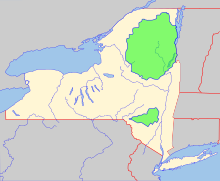
New York has many state parks and two major forest preserves. Adirondack Park, roughly the size of the state of Vermont and the largest state park in the United States, was established in 1892 and given state constitutional protection to remain "forever wild" in 1894. The thinking that led to the creation of the Park first appeared in George Perkins Marsh's Man and Nature, published in 1864. Marsh argued that deforestation could lead to desertification; referring to the clearing of once-lush lands surrounding the Mediterranean, he asserted "the operation of causes set in action by man has brought the face of the earth to a desolation almost as complete as that of the moon."
The Catskill Park was protected in legislation passed in 1885, [8] which declared that its land was to be conserved and never put up for sale or lease. Consisting of 700,000 acres (2,800 km2) of land, [8] the park is a habitat for bobcats, minks and fishers. There are some 400 black bears living in the region. The state operates numerous campgrounds and there are over 300 miles (480 kilometres) of multi-use trails in the Park.
The Montauk Point State Park boasts the 1797 Montauk Lighthouse, commissioned under President George Washington, which is a major tourist attraction on the easternmost tip of Long Island. Hither Hills park offers camping and is a popular destination with surfcasting sport fishermen.
History
Prehistory

The first peoples of New York are estimated to have arrived around 10,000 BCE. Around 800 CE, Iroquoian ancestors moved into the area from the Appalachian region. The Point Peninsula Complex, the predecessors of the Algonquian peoples of New York, moved into the state around 1000 CE. [9] By around 1100 CE, the distinct Iroquoian and Algonquian cultures that would eventually be encountered by Europeans had developed. [10] The Iroquois were the most notable New York Indians; they used their dominance over the fur trade as a bargaining chip with Europeans, while other New York tribes were typically at the mercy of either European destruction or assimilation within the Iroquoian confederacy. [11] Algonquian tribes were less united with neighboring peoples and typically lived along rivers, streams, or the Atlantic Coast. [12] Despite European beliefs at the time, the natives were well established peoples with complex cultural systems. As stated by historian Milton Klein, the natives had "a complex and elaborate native economy that included hunting, gathering, manufacturing, and farming...[and were] a mosaic of Native American tribes, nations, languages, and political associations." [10]
Colonial period
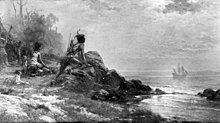
New York was first discovered by Giovanni da Verrazzano in 1524, [13] however it was not until 1609 that the Dutch laid claim to the land following Henry Hudson's voyage in search of a Northwest Passage. In 1614 the Dutch built Fort Nassau in present day Albany, which became the first European settlement in the state. Fort Orange was built to replace it in 1624. Fort Amsterdam was later built in 1626 at the southern tip of Manhattan Island. The resulting town of New Amsterdam would become the largest settlement in the colony of New Netherland. During its early decades, the colony was dependent on the fur trade, however the patroonship of Rensselaerswijck—a feudal manor surrounding Fort Orange—was able to bring about a successful agricultural industry. By the 1650s, under the leadership of Director Peter Stuyvesant, the colony was a main exporter of tobacco, wheat, and lumber; most of these commodities came through the village of Beverwijck, the predecessor of the city of Albany. A surprise attack with an overwhelming show of force allowed the English to conquer New Netherland in 1664; [Note 2] the lenient terms of surrender most likely also kept local resistance to a minimum. The colony and city were both renamed New York (and Beverwijck was renamed Albany) after its new proprietor, James the Duke of York and Duke of Albany. [Note 3] The population of New Netherland at the time of English takeover was about 7,000–8,000. [9] [16]
The 18th century saw the creation of large manors, including Livingston, Cortlandt, Philipsburg, and Rensselaerswyck. [Note 4] The manors represented more than half of the undeveloped land in the colony. The Province of New York thrived during this time, its economy made strong by Long Island and Hudson Valley agricultural output, in conjunction with trade and artisanal activity at the Port of New York; the colony was a breadbasket and lumberyard for the British sugar colonies in the Caribbean. New York saw a significant population increase during this century: from the first colonial census (1698) to the last (1771), the province grew from 18,067 to 168,007, a nine-fold increase. Immigration from Europe, including English, Scottish, Palatine German, and Irish, was the main source, though the slave trade brought in significant numbers of Africans. New York had the largest population of African slaves north of the Mason-Dixon Line; the group represented 16% of the population at its peak in 1720. [18]
New York saw its political scene dominated by factions between merchants and landlords; manorial families had also gained significant power due to their wealth and holdings. The colony was the center of numerous conflicts between the British and French throughout the 18th century. The French and Indian Wars raged on for more than 70 years, with breaks in between. New York was one of only two colonies regularly housing British troops before 1755; it was the military's base during the conflicts. The fighting brought natives against each other as well, as the Europeans took advantage of the groups for their own gain. Even during wars the colonists tried to gain control of Iroquoia, all while the confederacy strained to stay together. Regardless of the Covenant Chain, the British continued to expand into Indian land; the French were also guilty, and eventually found themselves being punished by the Iroquois through numerous bloody raids in 1701, forcing the French to ebb for a short time. [18]
Statehood to the Civil War

New York played a pivitol role during the Revolutionary War. The colony entered a state of resentment with the Stamp Act of 1765, bringing the Sons of Liberty—based in New York City—to the forefront of New York politics. This just exacerbated the postwar depression the province experienced after an unsuccessful invasion of Canada in 1760. [19] Even though many New York City merchants lost out on lucrative military contracts, an effort was made by the group to find middle ground between the King and the people; however, compromise was all but lost by the time of the Battles of Lexington and Concord in April 1775. New York's location gave it strategic significance during the war, indeed it was the key to domination in North America. As such, New York saw the largest fleet assembled in the century: at one point 30,000 British sailors and soldiers were anchored off Staten Island. General George Washington is considered lucky to have escaped New York City with his army in January 1776; General Sir William Howe was successful in driving Washington out of New York City, but overextended his reach into New Jersey, ending the active campaign in January 1777 with only a few outposts near the city. The British held New York City for the rest of the war, using it as a base for expeditions against other targets. However, American General Horatio Gates saw success in the Battle of Saratoga in October 1777, widely regarded as the turning point of the Revolution. Had Gates not held the ground, it has been suggested that the American rebellion would have broken down; taking Saratoga would in effect have meant the entire Hudson-Champlain corridor was taken, separating New England from the rest of the colonies, causing a literal split in the future union. [20]
Upon the end of the war, New York's borders became well defined: the counties east of Lake Champlain broke off to become Vermont and the state's western borders were defined by 1786. Because many Iroquois supported the British (typically out of fear of future effects of American ambitions), many were killed during the war; others went into exile with the British. Those remaining lived on twelve reservations; by 1826 only eight of those reservations remained, all of which still exist today. The state's constitution was adopted in April 1777, creating a strong executive and strict separation of powers; it would become a strong influence on the federal constitution a decade later. Debate over the federal constitution in 1787 led to formation of the groups known as Federalists—mainly downstaters who supported a strong national government—and Antifederalists—mainly upstaters who opposed large national institutions. In 1787, Alexander Hamilton, a strong Federalist from New York, wrote the first essay of the collection known as the Federalist Papers, published in New York City newspapers supporting the proposed constitution. Antifederalists were not swayed by the arguments, but still reluctantly ratified the United States Constitution in 1788. [21]
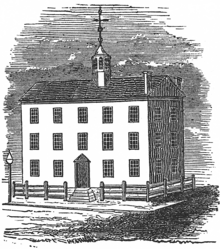
In 1785, New York City became the national capital and continued as such on and off until 1790; George Washington was inaugurated as the first President of the United States in front of Federal Hall in 1789. [21] In 1797, Albany became the permanent state capital; from statehood to this date, the Legislature had frequently moved the state capital between Albany, Kingston, Poughkeepsie, and New York City. [22] The early 19th century saw New York become a center for advancement in transportation: in 1807, Robert Fulton initiated a steamboat line from New York to Albany, the first successful enterprise of its kind; [23] by 1815, Albany was the turnpike center of the state, [24] establishing Albany as the hub of transportation for pioneers migrating west to Buffalo and the Michigan Territory; [25] in 1825 the Erie Canal opened, securing the state's economic dominance and providing economic opportunities throughout the state; [21] and in 1831 the Mohawk and Hudson Railroad started the first successful steam railroad running regularly-scheduled service in the country. [26] The Erie Canal's impact on its time cannot be understated: one source states, "Linking the Atlantic Ocean and the Great Lakes, the canal was an act of political will that joined the regions of the state, created a vast economic hinterland for New York City, and established a ready market for agricultural products from the state's interior." The year also saw the virtual end of New York's western frontier. By this time, all counties and most municipalities had been set up, approximately matching the organization today. [21]
The advancements in transportation quickly led to speculation and settlement of the fertile Mohawk and Gennessee valleys and the Niagara Frontier. Buffalo and Rochester became immediate boomtowns. Significant migration of New England "Yankees" (mainly of English descent) to the central and western parts of the state led to minor conflicts with the more settled "Yorkers" (mainly of German, Dutch, and Scottish descent). More than 15% of the state's population had been born in New England by 1850. The western part of the state saw the most growth at this time and by 1840, New York was home to 7 of the 30 largest cities in the nation. [Note 5]
The first half of the 19th century saw New York culture bloom: in 1809 Washington Irving wrote the satirical A History of New York under the pen name Deitrich Knickerbocker and in 1819 he based Rip Van Winkle and The Legend of Sleepy Hollow in rural Hudson Valley towns; [28] Thomas Cole's Hudson River school established itself in the 1830s by showcasing dramatic landscapes of the Hudson Valley; [29] New York City saw the first modern baseball teams form in the 1840s, including the New York Knickerbockers; and Saratoga Race Course, an annual summer attraction in Saratoga Springs, opened in 1847. [30]
Civil War to World War II
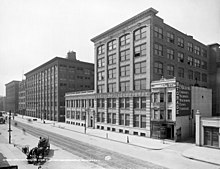
New York saw hundreds of thousands of its young men fight during the Civil War, having sent more men and more money to fight than any other Northern state. New York City saw a unique circumstance, in that much of its trade was based on moving Southern goods. A war was not in the best interest of business; the city's large Democratic community feared the impact of Abraham Lincoln's election in 1860, but by the time of the Battle of Fort Sumter in 1861, political differences vanished and the state quickly met Lincoln's request for soldiers and supplies. While no battles were waged in New York, the state wasn't immune to Confederate conspiracies, including one to burn various New York cities and another to invade the state via Canada. [31]
The decades following the Civil War saw New York strengthen its dominance of the financial and banking industries. Manufacturing was also on the rise: Eastman Kodak in Rochester, General Electric in Schenectady, and Endicott-Johnson Shoe Company in the Triple Cities are some of the well-known companies that sprung up during that time. Additionally, Buffalo and Niagara Falls saw the construction of numerous factories following the advent of hydroelectric power in the area. [32] With industry blooming, workers began to unite in New York as early as the 1820s and by 1882 the Knights of Labor in New York City had 60,000 members. Trade unions were able to use political influence to limit working hours by as early as 1867. At the same time, New York saw its agricultural peak and a change from a farm-based agricultural economy in Upstate to a dairy-based one. By 1881, the state had more than 241,000 farms. [32]
The last half of the 19th century saw a boom in immigration in the state. Starting with the Irish potato famine in the 1840s, New York became a starting point for a new life in the United States. [32] Between 1855 and 1890 an estimated 8 million immigrants passed through Castle Clinton at Battery Park in Manhattan. [33] [Note 6] Early in this period, most of the state's immigrants came from Ireland and Germany. Ellis Island opened in 1892 [33] and between 1880 and 1920, most immigrants were Italians, German Jews, Poles, and other eastern and southern European ethnicities. By 1925, New York City's population outnumbered that of London; it had become the most populous city in the world. [32] Arguably New York's most identifiable symbol, Liberty Enlightening the World (the Statue of Liberty), a gift from France for the American centennial, was completed in 1886. By the early 20th century, the statue was regarded as the "Mother of Exiles", a symbol of hope to immigrants. [35]
New York's current political pattern is largely unchanged from when it grew in the mid 19th century. New York City has been heavily Democratic and Upstate has been heavily Republican since that time. The 1850s saw the development of one of the most powerful political machines in United States history: the Democratic Tammany Hall in New York City. Boss William Tweed brought the organization to the forefront of city and then state politics in the 1860s. Tammany would have significant influence until at least the 1930s. On the other hand, state Republicans were able to influence the redistricting process enough to systematically underrepresent New York City and capture the Legislature in 1894. Both parties have seen legitimate political success: in the 39 presidential elections since 1856, the state gone Republican 19 times and Democratic 20 times. [32]
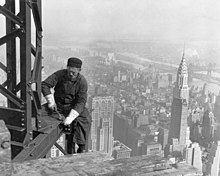
By 1900, New York was the richest and most populated state in the country. Two years prior, the five boroughs of New York City were consolidated into one city. [36] Within decades, the city's emblem was the skyscraper: the Woolworth Building opened up as the tallest building in the world in 1913, only to be surpassed by 40 Wall Street in April 1930, the Chrysler Building in May 1930, the Empire State Building in 1931, and the World Trade Center in 1972; New York City was home to the world's tallest building from 1908 to 1974. [37]
The early 20th century brought about a significant, but very much New York style of Progressivism, later known as "the New York Idea". Theodore Roosevelt, governor 1899-1900, and the Republicans of the time are credited with its creation. "Its main concerns included the righting of social ills, conservation, the discarding of ineffective and corrupt urban government, and control of trusts and other industrial combinations." Democrats continued the ideology, however they "were more concerned about factory labor and urban problems and had closer ties to immigrants and organized labor." Democrats' efforts in Progressivism impacted much of the national party as a whole: "The Democratic Party developed a new image—at once urban and reform minded, pro-immigrant and welcoming to African Americans—that increasingly defined the northern Democratic Party." [36]
New York enjoyed a booming economy during the Roaring Twenties, but felt the brunt of the Great Depression, which began with the Wall Street crash on Black Tuesday in 1929. The creation of the Securities and Exchange Commission in 1934 brought government regulation to the system, but not much progress during the 1930s. [38] Franklin Delano Roosevelt, elected governor in 1928, was tasked with fixing a state that was dealing with upwards of 25% unemployment. His Temporary Emergency Relief Agency, established in 1931, was the first work relief program in the country. Roosevelt's successful run for president in 1932 can offer much credit to his record as governor and his promises to extend relief programs in New York to the country as a whole; his New Deal incorporated many aspects from his programs as governor. [36] [39] Still, recovery was slow during the decade of the 1930s.
World War II to 9/11
New York supplied the most people and products in the country to support the American efforts during World War II. The war affected the state both socially and economically. For example, to overcome discriminatory labor practices, which were exacerbating a time of limited number of workers, Governor Herbert H. Lehman created the Committee on Discrimination in Employment in 1941 and Governor Thomas E. Dewey signed the Ives-Quinn bill in 1945, banning employment discrimination. The G.I. Bill of 1944, which offered returning soldiers the opportunity of cheap higher education, forced New York to create a public university system since its private universities would not be able to handle the influx of students; the State University of New York was created by Gov. Dewey in 1948. [40]
The efforts during WWII constituted the last great industrial era for New York. At the conclusion of the war, hundreds of thousands of defense workers lost their jobs (including women and minorities, who had found it difficult to find work before the war, and then again after the war when all the former, mainly white, male workers returned home). [40] Regardless, the years following the war saw the middle class rise in importance, especially with post-war suburbanization on Long Island and the counties north of New York City. The automobile accelerated suburbanization; planned communities like Levittown led to cheap, quick construction of middle-class housing. [41] New York entered its third golden age of transportation (after the canals and railroads) with the construction and opening of the New York State Thruway. The project was unpopular with New York City Democrats, who referred to it as "Dewey's ditch" and the "enemy of schools", because the Thruway disproportionately served upstaters. The highway was based on the German Autobahn and was unlike anything seen at that point in the United States. It was within 30 miles (48 km) of 90% of the state population at the time of its conception. With $600 million invested, the full 427-mile (687 km) project opened in 1956. [42]
Due to the significant suburbanization that New York experienced, the larger cities in the state stopped growing after 1950. None of these cities have reversed this trend since, except New York City, but growth did not occur there for another thirty years. The process was so rampant that Buffalo saw its population cut in half between 1950 and 2000. With immigration at a lower level than most of its history, New York saw its population decline for the first time ever between 1970 and 1980. California and Texas eventually overcame New York's population, meaning New York lost its place as the largest delegation to the House of Representatives. The state lost much of its manufacturing base in the second half of the 20th century. Companies primarily moved to the south and west due to lower taxes and a cheaper, non-unionized workforce. Much of the population loss is blamed on the decline in the state's industrial output. [41]
New York liberalism saw some change with the tenure of Nelson Rockefeller as governor (1959–1973). His time began with a notably liberal Republican administration, but ended more conservative with his decisions to hold back SUNY's growth, his reaction to the Attica Prison riot, and the implementation of the uniquely severe Rockefeller Drug Laws. New York City found itself nearly at bankruptcy in 1975, which eventually led to better fiscal prudence. The problems in New York City epitomized a time when Albany and Washington were leaving their former liberal ways and beginning to tighten their economic belts to save money and close budget gaps. [41]
The Executive Mansion was retaken by Democrats in 1974 and remained under Democratic control for 20 years under the governorships of Hugh Carey and Mario Cuomo. Late-century Democrats became more centrist, including US Senator Daniel Patrick Moynihan (1977–2001) and New York City Mayor Ed Koch (1978–1989), while state Republicans began to align themselves with the more conservative national party, gaining power through the elections of Senator Alfonse D'Amato in 1980, Mayor Rudolph Giuliani in 1993, and Governor George Pataki in 1994. Regardless of a loss of its historic liberalism, New York is still one of the most liberal states in the country; its electoral votes have not been won by a Republican since 1984. [41]
The economy of the late 20th century saw a drastic change where service, communication, and high-tech industries filled in gaps left by a declining manufacturing industry. New York City was especially successful at making the transition. Gone were the days of few companies with thousands of employees; entrepreneurs led the way with many small companies employing fewer people. This success saw many young professionals move into the dwindling cities and a surge in culture was experienced where New York City became, once again, "the center for all things chic and trendy", as The Encyclopedia described it. [41]
The state was changing socially as well. The 1980s brought about the advent of hip-hop and rap, much of which can source itself to New York City. Immigration to both the city and state rose, showing confidence in the growing economy, though the state was still dealing with large socio-economic issues like the rising cost of welfare, housing, education, and healthcare. New York City, with a more mature gay and lesbian culture, was hit hard by the AIDS crisis of the 1980s. [41] New York City also became even more of a media center during the last decades of the century, being the broadcast point for all of the Big Three Television Network news broadcasts as well as two of the three major cable news networks following their inception in the 1980s and 1990s.[ citation needed] The Wall Street Journal and The New York Times are two of the three most circulated newspapers in the country, with the latter being considered a national newspaper of record.[ citation needed]
Upstate did not fare as well as the City; the major industries that began to reinvigorate New York City did not typically spread beyond city limits. The number of farms in the state had fallen to 30,000 by 1997. City populations continued to decline while suburbs grew in physical size, but not by much in population. [41] Upstate did see a rise in the high-tech industry in cities such as Corning and Rochester. The 1990s saw a bull market, and success on Wall Street saw larger tax revenues for social programs and larger government in the state. New York entered the new millenium "in a position of economic strength and optimism," as phrased by Encyclopædia Britannica. [2]
9/11 to today
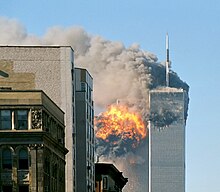
New York entered a new era following the September 11 attacks. [43] The worst terrorist attack to ever take place on US soil saw the Twin Towers of the World Trade Center destroyed by two hijacked airliners, killing upwards of 2,750 people in New York. [44] The US saw a swell in patriotism while New Yorkers saw a surge in city and state pride. Aftereffects of the attack will last for decades, however, with increased security at airports and public spaces, the swift implementation of the controversial USA PATRIOT Act in 2001, and an ongoing global War on Terror. New York City—and the country as a whole—saw a significant increase in bigotry toward Muslims. [44]
Although noted for being one of the most dysfunctional Legislatures in the country,[ citation needed] incumbent reelection rates far exceed 90% and in 2002 only one incumbent in each house was defeated. [45]
Demographics
| |||||||||||||||||||||||||||||||||||||||||||||||||||||||||||||||||||||||||||||||||||||||||||||||||||||
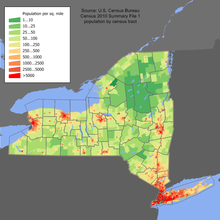 |
As of 2006, New York was the third largest state in population after California and Texas, [47] with an estimated population of 19,541,453 as of July 1, 2009. [48] This represents an increase of 513,481, or 2.7%, since the last census in 2000. [49] It includes a natural increase since the last census of 803,680 people (that is 2,072,765 births minus 1,269,085 deaths) and a decrease due to net migration of 698,895 people out of the state. [49] Immigration from outside the United States resulted in a net increase of 876,969 people, and migration within the country produced a net loss of 1,575,864 people. [49] In spite of the open land in the state, New York's population is very urban, with 92% of residents living in an urban area. [50] The center of population is located in Sullivan County outside of Cuddebackeville, near the Sullivan- Orange County line. [34]
New York is a slow growing state with a large rate of domestic migration to other states. In 2000 and 2005, more people moved from New York to Florida than from any one state to another. [51] However, New York state is one of the leading destinations for international immigration and thus has the second largest immigrant population in the country (after California) at 4.2 million as of 2008. Although Upstate New York receives considerable immigration, most of the state's immigrants settle in and around New York City, due to its more vibrant economy and cosmopolitan culture.
New York has no official language[ citation needed] because, linguistically, New York is relative diverse, thanks mainly to the demographic range of the population of New York City. English is the only language spoken by 12,977,510 (71.0%) New Yorkers, though it is spoken "very well" by an additional 2,863,897 (15.6%) for a total of 86.6% of the state population. Among speakers of other languages Spanish is the most common with 2,588,384 (14.2%), and a total of 1,656,844 (9.1%) people speak other Indo-European languages. [52]
As of 2008
[update], New York had an estimated population of 19,428,881 which is an increase of 148,238, or about 0.75%, from the prior year
[53] and an increase of 452,424, or 2.4%, since the year 2000.
[54] This includes a decrease from net migration of 589,175 people out of the state.
Immigration from outside the United States resulted in a net increase of 859,994 people, and migration within the country produced a net decrease of 1,449,169 people.
[55]
Population
The center of population of New York is located in Orange County, in the town of Deerpark. [56] New York City and its eight suburban counties (excluding those in New Jersey, Connecticut, and Pennsylvania) have a combined population of 13,209,006 people, or 68.42% of the state's population. [57]
Racial and ancestral makeup

The major ancestry groups in New York state are African American (15.8%), Italian (14.4%), Irish (12.9%), and German (11.1%). [58] According to a 2004 estimate, 20.4% of the population is foreign-born.
New York is home to the largest African American population and the second largest Asian American population in the United States. In addition it is home to the largest Puerto Rican, Dominican and Jamaican American populations in the continental United States. The New York City neighborhood of Harlem has historically been a major cultural capital for African-Americans of sub-Saharan descent, and Bedford Stuyvesant is the largest such population in the United States.
Queens, also in New York City, is home to the state's largest Asian-American population, and is also the most diverse county in the United States. The second concentration of Asian-Americans is in Manhattan's Chinatown. Queens is home to the largest Andean population ( Colombian, Ecuadorian, Peruvian and Bolivian) population in The United States of America.
In the 2000 Census, Italian Americans made up the largest ancestral group in Staten Island and Long Island, followed by Irish Americans. Albany and southeast-central New York also have populations with many of Irish-American and Italian-American descent. In Buffalo and western New York, German Americans are the largest group; in the northern tip of the state, French Canadians are. New York State has a higher number of Italian Americans than any other U.S. state.
6.5% of New York's population were under 5 years of age, 24.7% under 18, and 12.9% were 65 or older. Females made up 51.8% of the population.
According to the 2000 U.S. Census, 13.61% of the population aged 5 and over speak Spanish at home, while 2.04% speak Chinese (including Cantonese and Mandarin), 1.65% Italian, and 1.23% Russian. [59]
Religion
Catholics comprise more than 40% of the population in New York. [60] Protestants are 30% of the population, Jews 8.4%, Muslims 3.5%, Buddhists 1%, and 13% claim no religious affiliation. The largest Protestant denominations are the United Methodist Church with 403,362; the American Baptist Churches USA with 203,297; and the Episcopal Church with 201,797 adherents. [61]
Administrative divisions

New York is split into numerous administrative divisions, the highest being the county level. New York has 62 counties. Counties are made up of towns and cities. Villages are also possible and can either be restricted to one town or can cross borders between towns, however villages cannot be within city limits. All residents of a village are also residents of a town.
Economy
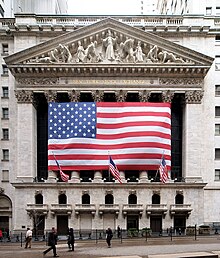
New York has one of the largest gross domestic products (GDP) in the world. In 2008, New York's GDP was $1.21 trillion, [Note 7] making it the second largest in the United States, behind California. [62] Similar to other Northeastern states, the service sector dominates New York's economy, along with an important—albeit shrinking— manufacturing sector. [2]
The economy of New York City is known for being a center of business, banking, and finance, as well as being the headquarters for hundreds of the world's largest and most profitable companies.
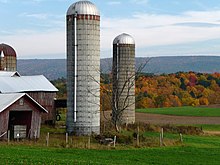
Upstate's economy is dependent mainly on agriculture, manufacturing, and government. Almost one third of the state is farmland and three-fifths of that is cropland; [2] farming is a $4.4 billion industry in New York. In 2007, the state had 36,350 farms, most of which were small, family-run farms consisting of less than 200 acres (81 ha) of farmland. [63] Dairy farming is the largest source of farm income and the state's agricultural staples include apples, cherries, peaches, currants, strawberries, tomatoes, peas, beans, sweet corn, and cabbage; the state is also on par with Vermont with respect to production of maple sugar products. The Hudson Valley and Finger Lakes regions are also known for wine production. [2] Although still an important segment of the Upstate economy, manufacturing output has been shrinking in recent decades.
Old
New York's gross state product in 2007 was $1.1 trillion, ranking third in size behind the larger states of California and Texas. [64] If New York were an independent nation, it would rank as the 16th largest economy in the world behind Turkey. Its 2007 per capita personal income was $46,364, placing it sixth in the nation behind Maryland, and eighth in the world behind Ireland. New York's agricultural outputs are dairy products, cattle and other livestock, vegetables, nursery stock, and apples. Its industrial outputs are printing and publishing, scientific instruments, electric equipment, machinery, chemical products, and tourism.
A recent review by the Center on Budget and Policy Priorities found 13 states, including several of the nation's largest, face budget shortfalls for FY2009. New York faces a deficit that could be as large as $4.3 billion. [65]
New York City is the leading center of
banking,
finance and
communication in the United States and is the location of the
New York Stock Exchange, the largest stock exchange in the world by dollar volume. Many of the world's largest corporations are based in the city.
The state also has a large manufacturing sector that includes printing and the production of garments, furs, railroad equipment and bus line vehicles. Many of these industries are concentrated in upstate regions. Albany and the Hudson Valley are major centers of nanotechnology and microchip manufacturing, while the Rochester area is important in photographic equipment and imaging.
Transportation

|

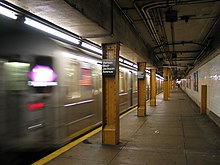
New York has one of the most extensive and one of the oldest transportation infrastructures in the country. Engineering difficulties because of the terrain of the state and the unique issues of the city brought on by urban crowding have had to be overcome since the state was young. Population expansion of the state generally followed the path of the early waterways, first the
Hudson River and then the
Erie Canal. Today, railroad lines and the
New York State Thruway follow the same general route. The
New York State Department of Transportation is often criticized for how they maintain the roads of the state in certain areas and for the fact that the tolls collected along the roadway have long passed their original purpose. Until 2006, tolls were collected on the Thruway within
The City of Buffalo. They were dropped late in 2006 during the campaign for Governor (both candidates called for their removal).
In addition to New York City's famous mass transit subway, four suburban commuter railroad systems enter and leave the city: the Long Island Rail Road, Metro-North Railroad, Port Authority Trans-Hudson, and five of New Jersey Transit's rail lines. Many other cities have urban and regional public transportation. In Buffalo, the Niagara Frontier Transportation Authority runs the Buffalo Metro Rail light-rail system; in Rochester, the Rochester Subway operated from 1927 until 1956 but has fallen into disuse.
The New York State Department of Motor Vehicles (NYSDMV or DMV) is the governmental agency responsible for registering and inspecting automobiles and other motor vehicles as well as licensing drivers in the U.S. state of New York. As of 2008, the NYSDMV has 11,284,546 drivers licenses on file [66] and 10,697,644 vehicle registrations in force. [67] All gasoline powered vehicles registered in New York State must get an emissions inspection every 12 months. Diesel powered vehicles with a Gross Weight Rating over 8 500 lb that are registered in the NY Metropolitan Area must get an annual emissions inspection. All vehicles registered in NYS must get an annual safety inspection.
Politics and government
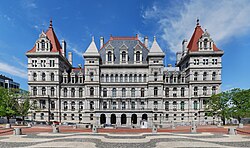
Under its present constitution (adopted in 1938), New York is governed by the same three branches that govern all fifty states of the United States: the executive branch, consisting of the Governor of New York and the other independently elected constitutional officers; the legislative branch, consisting of the bicameral New York State Legislature ( senate and assembly); and the judicial branch, consisting of the state's highest court, the New York Court of Appeals, and lower courts. The state has two U.S. senators, 29 members in the United States House of Representatives, and 31 electoral votes in national presidential elections (a drop from its 47 votes during the 1940s).
New York's capital is Albany. The state's subordinate political units are its 62 counties. Other officially incorporated governmental units are towns, cities, and villages. New York has more than 4,200 local governments that take one of these forms. About 52% of all revenue raised by local governments in the state is raised solely by the government of New York City, which is the largest municipal government in the United States, whereas New York City houses only 42% of the state population. [68]
The state has a strong imbalance of payments with the federal government. New York State receives 82 cents in services for every $1 it sends in taxes to the federal government in Washington. [69] The state ranks near the bottom, in 42nd place, in federal spending per tax dollar. [70]
Many of New York's public services are carried out by public benefit corporations, frequently called authorities or development corporations. Well known public benefit corporations in New York include the Metropolitan Transportation Authority, which oversees New York City's public transportation system, and the Port Authority of New York and New Jersey, a bi-state transportation infrastructure agency.
New York's legal system is explicitly based upon English common Law.
Federal representation
As of the 2000 census and the redistricting for the 2002 elections, the state has 29 members in the United States House of Representatives, and two U.S. senators. New York has 31 electoral votes in national presidential elections (a drop from its 47 votes during the 1940s).
New York is represented by Chuck Schumer and Kirsten Gillibrand in the United States Senate and has 29 representatives to the United States House of Representatives, behind California's 53 congressional districts and Texas' 32 congressional districts.
Capital punishment
Capital punishment was reintroduced in 1995 under the Pataki administration but the statute was declared unconstitutional in 2004, when the New York Court of Appeals ruled in People v. LaValle that it violated the state constitution. The remaining death sentence was commuted by the court to life imprisonment in 2007, in People v. John Taylor, and the death row was disestablished in 2008, under executive order from Governor Paterson. No execution has taken place in New York since 1963. Legislative efforts to amend the statute have failed, and death sentences are no longer sought at the state level, though certain crimes that fall under the jurisdiction of the federal government are subject to the federal death penalty. [71] [72] [73]
Politics

In the last few decades, New York State has generally supported candidates belonging to the Democratic Party in national elections. Democratic presidential candidate Barack Obama won New York State by 25 percentage points in 2008, a bigger margin than John Kerry in 2004. New York City is a major Democratic stronghold with liberal politics. Many of the state's other urban areas, such as Albany, Buffalo, Rochester, and Syracuse are also Democratic. Rural upstate New York, however, is generally more conservative than the cities and tends to favor Republicans. Heavily populated Suburban areas such as Westchester County and Long Island have swung between the major parties over the past 25 years, but more often than not support Democrats.
New York City is the most important source of political fund-raising in the United States for both major parties. Four of the top five zip codes in the nation for political contributions are in Manhattan. The top zip code, 10021 on the Upper East Side, generated the most money for the 2000 presidential campaigns of both George W. Bush and Al Gore. [74]
Education

The University of the State of New York oversees all public primary, middle-level, and secondary education in the state, while the New York City Department of Education manages the public school system in New York City.
At the college level, the statewide public university system is the State University of New York (SUNY). The City University of New York (CUNY) is the public university system of New York City. The SUNY system consists of 64 community colleges, technical colleges, undergraduate colleges and universities. The four university centers are University at Albany, Binghamton University, University at Buffalo and SUNY Stony Brook.
In addition there are many notable private universities, including the oldest Catholic institution in the northeast, Fordham University. New York is home to both Columbia University and Cornell University, making it the only state to contain more than one Ivy League school. West Point, the service academy of the U.S. Army is located just south of Newburgh, NY on the banks of the Hudson River.
During the 2007–2008 school year, New York spent more per pupil on public education than any other state. [75]
Sports
New York hosted the 1980 Winter Olympics at Lake Placid, the Games known for the USA–USSR hockey game dubbed the " Miracle on Ice" in which a group of American college students and amateurs defeated the heavily favored Soviet national ice hockey team 4–3 and went on to win the gold medal against Finland. Lake Placid also hosted the 1932 Winter Olympics. Along with St. Moritz, Switzerland and Innsbruck, Austria, it is one of the three places to have twice hosted the Winter Olympic Games.
New York is the home of one National Football League team, the Buffalo Bills (based in the suburb of Orchard Park). Although the New York Giants and New York Jets represent the New York metropolitan area and were previously located in New York City, they play in New Meadowlands Stadium, located in East Rutherford, New Jersey. The Meadowlands stadium will host Super Bowl XLVIII in 2014. There has been much controversy over several proposals for a new New York Jets football stadium. The owners of the New York Jets were willing to split the $1.5 billion cost of building a new football stadium over Manhattan's West Side rail yards, but the proposal never came to fruition.
New York also has two Major League Baseball teams, the New York Yankees (based in the Bronx) and the New York Mets (based in Queens). New York is home to three National Hockey League franchises: the New York Rangers in Manhattan, the New York Islanders on Long Island and the Buffalo Sabres in Buffalo. New York has a National Basketball Association team, the New York Knicks, in Manhattan. The former New York Nets from 1968 to 1977 is now titled as a New Jersey team; however, plans to relocate to New York City are in the works. There are a variety of minor league teams that can be found all through the state of New York, such as the Long Island Ducks.
State symbols

New York is universally known by the nickname, " The Empire State", though the history of the term is not actually known. One possible source is an April 10, 1785, letter from George Washington to New York City Mayor James Duane in which Washington refers to New York City as "the Seat of the Empire", but no connection to common usage has ever been made. The state's wealth and vast resources are also commonly claimed as the nickname's origin. However, the source of the term has apparently been lost to history. It is known that the phrase has been in common usage since at least 1825. [76]
The state's motto, Excelsior, translates from Latin to "Ever upward", and is used on the state seal, which is seen at the center of the state flag. The seal was designed in 1777 and its latest revision dates to 1882; [77] the flag comprises the state seal on a blue background and is a modern version of a Revolutionary War flag, [78] though the current version was not adopted until 1902. [79] The majority of the other symbols were made official during the second half of the 20th century. [80] New York's state song is I Love New York. [81] The rest of the state emblems are as follows: [80]
- Animal: Beaver
- Beverage: Milk
- Bird: Eastern Bluebird
- Bush: Lilac
- Fish (fresh water): Brook Trout
- Fish (saltwater): Striped Bass
- Flower: Rose
- Tree: Sugar Maple
- Fossil: Eurypterus remipes
- Gem: Garnet
- Insect: Lady Bug
- Reptile: Common Snapping Turtle
- Motto: Excelsior
- Nickname: The Empire State
- Shell: Bay Scallop
- Muffin: Apple Muffin
- Slogan: I ♥ New York
See also
Notes
- ^ For the purposes of this article, the term New York refers only to the state. When referring to the city, the full name New York City is used.
- ^ The takeover is commonly said to have been part of the Second Anglo-Dutch War, however this war was not officially declared until 1665; the Dutch and English were actually at peace at the time. [14]
- ^ James Stuart (1633–1701), brother and successor of Charles II, was both the Duke of York and Duke of Albany before being crowned James II of England and James VII of Scotland in 1685. [15]
- ^ "Rensselaerswyck" is the Anglicized form of the Dutch Rensselaerswijck. The patroonship was confirmed as an English manor by Charles II in 1664. [17]
- ^ New York City (1st at 312,710), Brooklyn (7th at 36,233), Albany (9th at 33,721), Rochester (19th at 20,191), Troy (21st at 19,334), Buffalo (22nd at 18,213), Utica (29th at 12,782). [27]
- ^ For comparison, New York's population in 1890 was just over 5 million. [34]
- ^ This value has been adjusted for inflation to equivalent 2008 dollars (i.e., the year the study was done); the source gives this value in 2000 dollars: $964,755 million. [62]
References
-
^
"2000 Census of Population and Housing" (PDF).
United States Census Bureau. April 2004. p. 71. Retrieved 2010-09-26.
{{ cite web}}: CS1 maint: date and year ( link) - ^ a b c d e f g "New York". Encyclopædia Britannica Online. Encyclopædia Britannica. 2010. Retrieved 2010-09-26.
- ^ "New York State Travel Guide 2010". New York Department of Economic Development. 2010. p. 4. Retrieved 2010-09-26.
- ^ The Encyclopedia (2005), p. xvi
- ^ "Climate of New York". New York State Climate Office – Cornell University. Retrieved April 10, 2008.
- ^ The New York Post (2007-06-03). "A Breath of Fresh New York Air". Retrieved 2007-06-06. [ dead link]
- ^ "Typical High and Low Temperatures For Various New York Cities". US Travel Weather. Retrieved March 24, 2010.
- ^ a b "Catskill Park History". www.catskillpark.org. Retrieved April 11, 2008.
- ^ a b The Encyclopedia (2005), p. xx
- ^ a b Klein (2001), p. 3
- ^ Klein (2001), pp. 6–7
- ^ Klein (2001), p. 7
- ^ "Giovanni da Verrazzano". Encyclopædia Britannica Online. Encyclopædia Britannica. Retrieved 2010-10-10.
- ^ The Encyclopedia (2005), p. 1053 (article: "New Netherland")
- ^ Kenyon, John P. "James II". Encyclopædia Britannica Online. Encyclopædia Britannica.
-
^ Campbell, Alan K. "New York". Encyclopædia Britannica Online.
Encyclopædia Britannica.
{{ cite encyclopedia}}: Unknown parameter|coauthors=ignored (|author=suggested) ( help) - ^ Reynolds, Cuyler. Albany Chronicles: A History of the City Arranged Chronologically, From the Earliest Settlement to the Present Time. Albany: J. B. Lyon Company; 1906. p. 66.
- ^ a b The Encyclopedia (2005), pp. xx–xxi
- ^ Klein (2001), p. 202
- ^ The Encyclopedia (2005), pp. xxi–xxii
- ^ a b c d The Encyclopedia (2005), p. xxii
- ^ The Magazine of American History with Notes and Queries. Historical Publication Co; 1886. p. 24.
- ^ McEneny (2006), p. 92
- ^ McEneny (2006), p. 75
- ^ Albany. (2010). Encyclopædia Britannica. Retrieved November 10, 2010, from Encyclopædia Britannica Online.
- ^ New York State Department of Transportation. History of Railroads in New York State [Retrieved 2010-06-04].
- ^ United States Census Bureau (1840). "Population of the 100 Largest Urban Places: 1840". United States Department of Commerce. Retrieved 2010-11-10.
- ^ The Encyclopedia (2005), p. 798 (article: "Irving, Washington")
- ^ The Encyclopedia (2005), p. 359 (article: "Cole, Thomas")
- ^ The Encyclopedia (2005), p. xxiv
- ^ The Encyclopedia (2005), pp. 335–337 (article: "Civil War")
- ^ a b c d e The Encyclopedia (2005), p. xxv
- ^ a b The Encyclopedia (2005), p. 498 (article: "Ellis Island")
- ^ a b c "New York: 2000 (Population and Housing Unit Counts)" (PDF). 2000 United States Census. United States Census Bureau. 2000. Retrieved 2010-09-18. (page 1 of the document, page 31 of the file) Cite error: The named reference "census" was defined multiple times with different content (see the help page).
- ^ The Encyclopedia (2005), p. 1473 (article: "Statue of Liberty")
- ^ a b c The Encyclopedia (2005), p. xxvi
- ^ The Encyclopedia (2005), pp. 1417–1418 (article: "Skyscrapers")
- ^ The Encyclopedia (2005), pp. 1102–1103 (article: "New York Stock Exchange")
- ^ The Encyclopedia (2005), pp. 1334–1335 (article: "Roosevelt, Franklin Delano")
- ^ a b The Encyclopedia (2005), pp. 1726–1728 (article: "World War II")
- ^ a b c d e f g The Encyclopedia (2005), p. xxvii
- ^ The Encyclopedia (2005), pp. 1100–1102
-
^ Cite error: The named reference
encycxxviiiwas invoked but never defined (see the help page). - ^ a b The Encyclopedia (2005), pp. 1395–1401 (article: "September 11th, 2001")
- ^ The Encyclopedia (2005), pp. 876–880 (article: "legislature")
- ^ "Resident Population of the 50 State, the District of Columbia, and Puerto Rico: 2010 Census" (PDF). 2010 United States Census. United States Census Bureau. 2010. Retrieved 2010-12-22.
- ^ "Estimates of Population Change for the United States and States, and for Puerto Rico and State Rankings: July 1, 2005 to July 1, 2006". Archived from the original (Excel Spreadsheet) on March 11, 2007. Retrieved 2007-01-05.
-
^ Cite error: The named reference
09CenEstwas invoked but never defined (see the help page). - ^ a b c U. S. Census Bureau (2008-12-15). "Cumulative Estimates of the Components of Population Change for the United States, Regions and States: April 1, 2000 to July 1, 2008 (NST-EST2008-04)" (CSV). Retrieved 2009-01-16.
- ^ New York Fact Sheet: NY agriculture income population food education employment farms top commodities exports counties financial indicators poverty organic farming farm income America USDA
- ^ "Domestic Migration Flows for States from the 2005 ACS" (Microsoft Word). Retrieved 2007-10-19.
- ^ "New York Selected Social Characteristics in the United States". United States Census Bureau. 2008. Retrieved 2010-09-18.
- ^ "New York ACS Demographic and Housing Estimates: 2006-2008". United States Census Bureau. 2008. Retrieved 2010-09-18.
- ^ "American FactFinder". United States Census Bureau. Retrieved 2008-01-31.
- ^ "State Resident Population—Components of Change: 2000 to 2007" (PDF). United States Census Bureau. December 27, 2007. Retrieved April 6, 2010.
- ^ "Population and Population Centers by State: 2000" (Text). Retrieved 2007-01-05.
- ^ "DP-3. Profile of Selected Economic Characteristics: 2000, Geographic Area: New York". U.S. Census Bureau, Census 2000. Retrieved 2007-01-05.
- ^ Awesome America: New York. RetrieveAugust d 18, 2007.
- ^ "Language Map Data Center". Mla.org. 2007-07-17. Retrieved 2010-07-02.
-
^ Egon Mayer, Ph.D. (2001).
"American Religious Identification Survey(Key Findings)". The City University of New York. Retrieved January 5, 2007.
{{ cite web}}: Unknown parameter|coauthors=ignored (|author=suggested) ( help) - ^ The Association of Religion Data Archives | Maps & Reports
- ^ a b "GDP by State" (Press release). US Department of Commerce Bureau of Economic Analysis. 2009-06-02. Retrieved 2010-09-28.
- ^
a
b
"The Role of Agriculture in the New York State Economy" (PDF).
New York State Office of the State Comptroller. February 2010. Retrieved 2010-09-28.
{{ cite web}}: CS1 maint: date and year ( link) - ^ The Bureau of Economic Analysis (2006-08-26). "Gross Domestic Product (GDP) by State, 2005". Retrieved 2007-02-08.
- ^ 13 States Face Total Budget Shortfall of at Least $23 Billion in 2009; 11 Others Expect Budget Problems, 12/18/07, Center on Budget and Policy Priorities
- ^ "NYS DMV – Statistics – NYS Driver Licenses on File – 2008". Nydmv.state.ny.us. Retrieved 2010-07-02.
- ^ "NYS DMV – Statistics – Vehicle Registrations in Force – 2008". Nydmv.state.ny.us. Retrieved 2010-07-02.
-
^ Office of the New York State Comptroller (2006-11).
"2006 Annual Report on Local Governments" (PDF). Retrieved 2006-11-14.
{{ cite news}}: Check date values in:|date=( help) - ^ New York City Finance Division (2005-03-11). "A Fair Share State Budget: Does Albany Play Fair with NYC?". Retrieved 2006-07-19.
- ^ "Federal Spending in Each State Per Dollar of Federal Taxes FY2005". Tax Foundation. Retrieved April 12, 2008.
- ^ Rob Gallagher (2005-10-25). "New York Executions". Archived from the original on May 28, 2008. Retrieved 2009-04-09.
- ^ Scott, Brendan (2008-07-24). "GOV PULLS SWITCH ON DEATH CELL". New York Post. Retrieved 2009-04-09.
- ^ Powell, Michael (2005-04-13). "In N.Y., Lawmakers Vote Not to Reinstate Capital Punishment". The Washington Post. Retrieved 2008-04-11.
- ^ Opensecrets.org (2005-05-16). "2006 Election Overview: Top Zip codes". Retrieved 2006-07-19.
- ^ Thomas, G. Scott. "New York Leads Nation in Education Spending". The Business Review. American City Business Journals, Inc. Retrieved 2010-06-29.
- ^ Klein (2001), pp. xix–xx
- ^ New York State Department of State. Great Seal of New York State [Retrieved 2010-09-19].
- ^ New York State Library. New York State Flag and Great Seal of the State of New York [Retrieved 2010-09-19].
- ^ New York, flag of. (2010). Encyclopædia Britannica. Retrieved September 19, 2010, from Encyclopædia Britannica Online.
- ^ a b New York State Library. New York State Information; 2010-05-28 [Retrieved 2010-09-10].
- ^ New York State Library. I Love New York Song; 2009-04-29 [Retrieved 2010-09-19].
Bibliography
- Brodhead, John Romeyn. History of the State of New York. New York City: Harper & Brothers; 1874. OCLC 458890237.(Full text via Google Books.)
- Eisenstadt, Peter (ed.). The Encyclopedia of New York State. Syracuse, New York: Syracuse University Press; 2005. ISBN 081560808X.; Cited as "The Encyclopedia"
- French, John Homer. Historical and Statistical Gazetteer of New York State. Syracuse, New York: R. Pearsall Smith; 1860. OCLC 224691273.(Full text via Google Books.)
- McEneny, John. Albany, Capital City on the Hudson: An Illustrated History. Sun Valley, California: American Historical Press; 2006. ISBN 1892724537.
- New York State Historical Association. In: Milton M. Klein. The Empire State: A History of New York. Ithaca, New York: Cornell University Press; 2001. ISBN 0801438667.
- New York State Historical Association. New York: A Guide to the Empire State. New York City: Oxford University Press; 1940. ISBN 9781603540315. OCLC 504264143.(Full text via Google Books.)
External links
General
Government
- State Government website
- Governor of New York State, David Paterson
- New York State Senate
- New York State Assembly
- New York State Unified Court System
-
Constitution of New York (or see
 Wikisource)
Wikisource)
Tourism and recreation
Culture and history
- New York State Historical Association
- New York State Cultural Education Center
- New York State Guide from the Library of Congress
Maps and Demographics